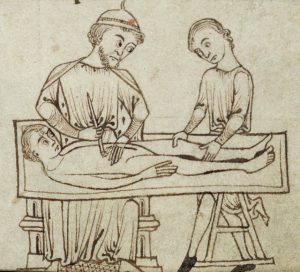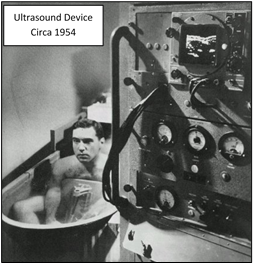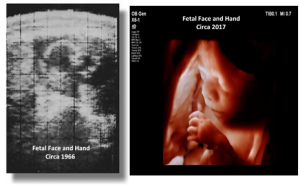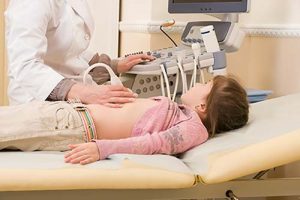Exploratory Surgery and the Progress of Medical Imaging
Wayne Moore, B.Sc., MBA, FASE
8/8/17
 “We found the problem, it’s going to be ok”. When a mom, siting alone in a hospital waiting room, stressing over why their beautiful child is having severe abdominal pain, with a million things going through their mind – all of them bad, those words “it’s going to be ok” are like salve from heaven.
“We found the problem, it’s going to be ok”. When a mom, siting alone in a hospital waiting room, stressing over why their beautiful child is having severe abdominal pain, with a million things going through their mind – all of them bad, those words “it’s going to be ok” are like salve from heaven.
You know, it wasn’t all that long ago when physicians did not have MR, CT, and Ultrasound imaging systems. They did have X-ray systems, but X-ray was relatively useless with soft tissue. It was often necessary in the “pre-imaging” days to resort to exploratory surgery to make a definitive diagnosis. As with any type of surgery there was, in addition to the time and expense, also the all-too-real risk of perioperative morbidity and mortality resulting from the procedure. I for one am delighted we now have advanced imaging technologies that frequently obviate the need for exploratory surgery. I was invited once to give a lecture on advanced imaging technologies to a large group of medical service professionals, and I asked the questions; “how many in this audience think that medical imaging is overused?” In response to that question the majority of the audience raised their hands. I followed with another question; “Given the choice how many of you would rather have an MRI scan than exploratory surgery?” This time the vote was unanimous; the MRI scan won out.
 I entered the work force contemporaneously with the nascent modern diagnostic imaging market, specifically in the field of ultrasound. I say modern as there were pre-cursor ultrasound devices being developed and investigated in various institutions around the world, but they bare little resemblance to modern systems (they looked more like torture devices than medical devices – see photo to the right) in either form or in image result (see fetal image comparison below). I am so grateful to have witnessed, first hand, all the technological developments within medical imaging devices and the resultant profound impact those developments have made with non-invasive diagnosis, early diagnosis, and subsequent patient management. I am grateful that those advances have dramatically reduced the need for diagnostic exploratory surgery, and other invasive modalities such as cardiac catheterization. It is exciting to think about what additional advances the future will bring not only to ultrasound, but to MRI and other advanced imaging modalities as well. Smart-devices, Deep Learning algorithms, new materials, imaging and Doppler processing schemes – the future is wide open with possibilities. As the newer systems and probes become more complicated, so must Acertara’s efforts in designing commensurate test devices for these systems and probes, as well as creating new processes and procedures for repairing these devices.
I entered the work force contemporaneously with the nascent modern diagnostic imaging market, specifically in the field of ultrasound. I say modern as there were pre-cursor ultrasound devices being developed and investigated in various institutions around the world, but they bare little resemblance to modern systems (they looked more like torture devices than medical devices – see photo to the right) in either form or in image result (see fetal image comparison below). I am so grateful to have witnessed, first hand, all the technological developments within medical imaging devices and the resultant profound impact those developments have made with non-invasive diagnosis, early diagnosis, and subsequent patient management. I am grateful that those advances have dramatically reduced the need for diagnostic exploratory surgery, and other invasive modalities such as cardiac catheterization. It is exciting to think about what additional advances the future will bring not only to ultrasound, but to MRI and other advanced imaging modalities as well. Smart-devices, Deep Learning algorithms, new materials, imaging and Doppler processing schemes – the future is wide open with possibilities. As the newer systems and probes become more complicated, so must Acertara’s efforts in designing commensurate test devices for these systems and probes, as well as creating new processes and procedures for repairing these devices.

As the CEO of an ultrasound probe repair service provider, I am mindful of the importance that our efforts at Acertara plays in assuring the best possible clinical and safety performance from an ultrasound device. Our on-going internal training, our ISO13485 quality management system, and our R&D efforts developing new and innovative ultrasound test devices are all focused on the single most important factor in all of this – the patient. We are committed to, and focus on playing a vital role in the ability of the physician to speak those words of comfort; “We found the problem, it’s going to be ok”.
Until next month,
Wayne

About the Author, G. Wayne Moore:
A 30-year veteran of the diagnostic ultrasound market Wayne has held senior level positions with several major medical equipment manufacturers, including Honeywell Medical Systems and Siemens Medical Solutions. Wayne has been directly involved in the development and commercialization of more than 15 technologically intensive ultrasound systems. He is widely published in diagnostic ultrasound literature, a sought after speaker at medical imaging conferences, has served as an expert witness in multiple ultrasound litigations, and holds more than 16 United States ultrasound related patents. Wayne obtained his MBA from the University of Denver – Daniels College of Business.
He was elected as a Fellow of the American Society of Echocardiography (FASE) in 2009.
Acertara Acoustic Laboratories
Correspondence: Dave Dallaire
1900 South Sunset Street, Suite F, Longmont, CO 80501, USA
Email: [email protected]
www.acertaralabs.com
